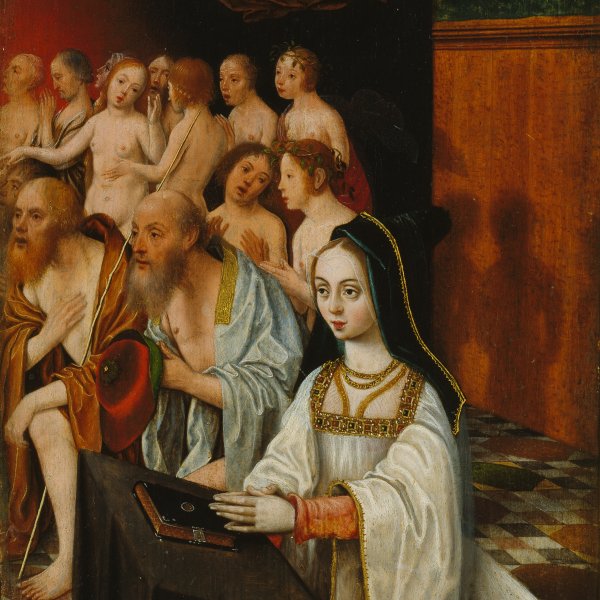The Birth of the Virgin
Jan de Beer was a painter active in the first third of the 16th century, associated with the group known as the Antwerp Mannerists. The work of these artists is characterised by the use of minute detail in the backgrounds and by the poses of the figures, resulting in a style that combined late Gothic and Renaissance elements. These two paintings must have been part of a larger ensemble depicting episodes from the life of the Virgin. The first panel depicts The Birth of the Virgin, an episode not narrated in the Gospels. We see Saint Anne in bed, praying, with the infant Virgin in the arms of one of the midwives whose anatomical proportions are highly elongated, like the rest of the figures. The room is filled with objects treated in the manner of independent, still-life elements, such as the metal pitcher and the basket, both of which appear in the foreground of each panel. The Annunciation has a markedly narrative sense, with the Virgin’s sewing implements abandoned on the floor on the Archangel’s arrival and the inclusion of the episode of The Visitation, visible through the window. In both paintings the objects in the rooms are particularly striking elements in the compositions, for example, the vase of lilies in the centre of The Annunciation.
NR
Jan de Beer was one of a group of painters known as the Antwerp Mannerists. Most of these artists, whose names remain unknown, worked in the city in the early decades of the 16th century. Among the characteristics of their style are the rather artificial figures and the interest in detail which led them to depict settings filled with incidental elements. De Beer was one of the leading artists of this group and his name is recorded in the Antwerp painters’ guild of Saint Luke as an apprentice in 1490. In 1504 he became an independent master. De Beer combined his activities as a painter with official positions in the guild and along with other artists he worked on the preparations for the entry of Charles V into the city. His oeuvre has been reconstructed on the basis of similarities with a signed and dated drawing of 1520 in the British Museum, published in 1913. In addition, Friedländer reconstructed a body of work attributed to a painter whom he called the Master of the Adoration of the Magi after the artist’s most important work in the Pinacoteca di Brera in Milan, and whom Friendländer considered to be Jan de Beer. As well as paintings, De Beer also executed designs for tapestries and stained glass, as well as a series of preliminary studies.
These two paintings, both of which have been cut down at the upper and side edges, belonged to a group on the Life of the Virgin. Three other panels have been associated with this series. De Beer set his compositions in sumptuously furnished bourgeois interiors filled with objects and based on daily life. In addition, many of the elements can be read in a symbolic key that emphasises the message of the scenes. For The Birth of the Virgin, an episode not recounted in the Gospels, De Beer depicted a room in which six busy women attend Saint Anne who lies on a bed in an attitude of prayer. The naked infant Virgin looks at her mother from the lap of one of these midwives who is seated in front of the fireplace. The artist’s interest in detail and in conveying a sense of vitality almost transform this religious scene into a genre composition. Particularly striking are the long proportions of the figures, most notably the woman in the foreground who carries a bowl of soup to Saint Anne, while the midwife on the left is similarly elongated. Jan de Beer reproduced objects to be found in compositions by Campin and Van Eyck such as the sewing basket in the foreground and the concave mirror inset into the centre of the window, which may be a reference to the Virgin as the speculum sine macula. The colour range is acidic with striking contrasts and juxtapositions such as the green, yellow and salmon pink in the foreground. Also notable are the shot colours of the draperies used for the headdresses or dresses seen, for example, in the figure in the background holding a candle.
The other panel of The Annunciation has an additional scene of the Visitation, visible through the window on the left. It also shares the same everyday setting and the emphasis on detail and decoration, for example the piece of sewing that the Virgin has left on the floor. Other domestic details include the black cat on the left and a small mouse running across the floor in the background on the left. An additional focus of attention in this scene is the majolica vase of flowers in the background, whose traditional white lilies are accompanied by aquilegia and marigolds.
These two panels have been related to three others: two in the Barber Institute in Birmingham (UK) of Saint Joseph and the flowering Staff and The Nativity, and a third in the Saint Louis Art Museum (Missouri) of The Marriage of the Virgin..
Mar Borobia










